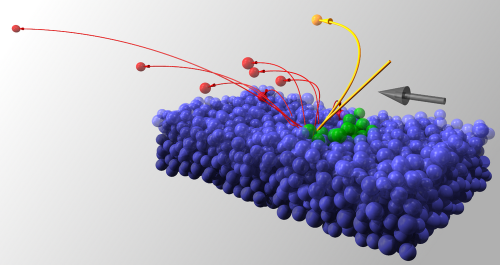In a simulated sandstorm, a salton (yellow) smashes into the dense particle bed near the ground and ejects particles called leapers (red). The arrow indicates wind direction. Credit: M. V. Carneiro et al., Phys. Rev. Lett. (2013)
(Phys.org) —A small team of researchers from China, Brazil and Switzerland has found that midair collisions that occur between grains of sand during a sandstorm lead to an increase in storm strength rather than a decrease as would be expected. In their paper published in the journal Physical Review Letters, the team describe how they developed a 3D computer simulation that was able to show how grains of sand behave in a storm and what they observed as a result.
Prior simulations had shown that the way sand storms get going is via a process whereby grains of sand that are lifted into the air by wind eventually slam back into other grains of sand on the ground, causing some of them to splash up into the air. In this new effort, the researchers have found that the process of sandstone creation and its existence thereafter is much more complicated than that.
To describe the different actions occurring with individual grains of sand during the creation of a sandstorm and how it behaves thereafter, researchers have given them names. Saltons are airborne sand particles that smash into other particles on the ground. Creepers are those that once kicked up by a collision, fall back to the ground almost right away, while leapers are those that shoot higher up into the air when impacted. Previously, it had been thought that leapers simply fell back to the ground as well, though because of their increased altitude, it would take longer—the new simulations show that's not how it works at all. What really happens, they say, is that many of the saltons wind up colliding with leapers as they descend, causing some of them to bounce back up higher into the air, high enough to become more energetic saltons. Those saltons then gain additional speed because of the wind that is pushing them forward, which explains why they create such a splash when they do eventually make it back down to the ground.
The team found that the collisions that occur in the air tend to cause the power of the storm to increase. In their simulation they found that turning off such collisions reduced the strength of a storm by a third. They also found that in adjusting the characteristics of the sand particles, that those that exist in the real world (those that lose approximately 30 percent of their kinetic energy during collisions) are the best suited for picking up energy due to collisions.
More information: Midair Collisions Enhance Saltation, Phys. Rev. Lett. 111, 058001 (2013) prl.aps.org/abstract/PRL/v111/i5/e058001
Abstract
Here we address the old question in aeolian particle transport about the role of midair collisions. We find that, surprisingly, these collisions do enhance the overall flux substantially. The effect depends strongly on restitution coefficient and wind speed. We can explain this observation as a consequence of a soft bed of grains which floats above the ground and reflects the highest flying particles. We make the unexpected observation that the flux is maximized at an intermediate restitution coefficient of about 0.7, which is comparable to values experimentally measured for collisions between sand grains.
Journal information: Physical Review Letters
© 2013 Phys.org






















